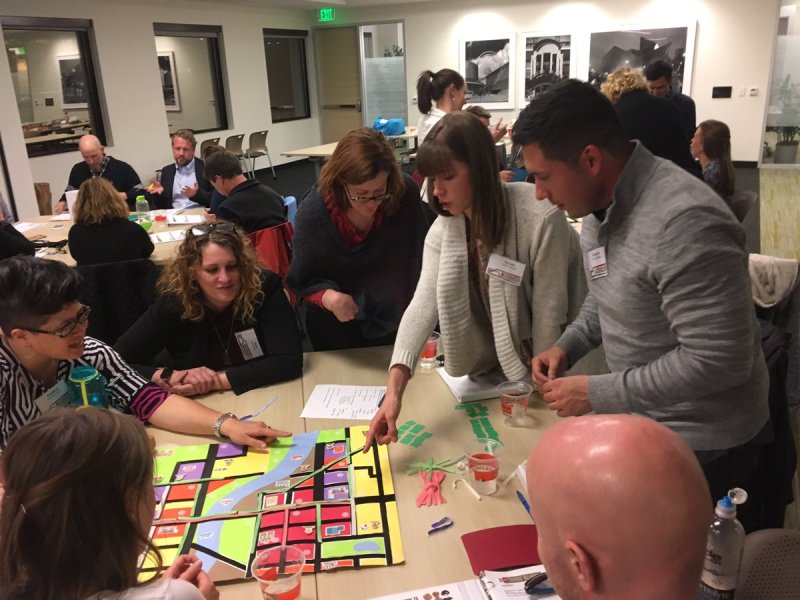Denver’s Transit Alliance Is Exporting Its Model for Citizen Advocacy to Baltimore

When Denver looks to peer cities that are doing transportation well, we look at Seattle. Turns out, the Baltimore region looks to us.
And advocates there recently looked to Transit Alliance, a longtime staple of Denver’s transit advocacy scene, to help them create an academy where people learn how to move the needle on sustainable transportation through civic engagement.
Transit Alliance created the Citizens’ Academy 10 years ago. Executive Director Kathleen Osher just helped the Central Maryland Transportation Alliance launch a similar program — the seven-week Transportation 101 Leadership Academy — which just finished its first season.
“A story you often hear in Baltimore is that there’s a lot of civic engagement,” said Eric Norton, director of policy and programs for CMTA. “There’s a lot of groups doing a lot of different things, but it could be described as fractured, with not a lot of coordination. I think there was a public education gap that we’re filling.”
Back in Denver, the Citizens’ Academy has made marks on the city — several marks, actually. Gosia Kung, founder and executive director of WalkDenver, credits the academy with inspiring her to create the pedestrian advocacy group. Ian Harwick, co-founder of YIMBY Denver, is another graduate. Kung and Harwick are just two grads of nearly 900 over the years — including six former and current RTD board members, a state senator, three state representatives, and four of the six citizen co-chairs of the Denveright planning initiative.
Baltimore’s transportation problems are stark. Buses and trains funnel people downtown, but that’s not where most jobs are for people without college degrees, says CMTA President Brian O’Malley. The city’s one subway line doesn’t really connect to the light rail, and the bus system doesn’t serve the one-third of car-free and transit-dependent people well enough.
“One big need is that we’ve got neighborhoods cut off from opportunity,” O’Malley says. “You have a third of workers spending 45 minutes or more commuting, and lots of signs of structural racism. We’ve sort of designed a system of jobs and transportation that cuts these neighborhoods off, even though they’re centrally located.”
Baltimore hasn’t done a comprehensive update to its transit plan — like Denver is attempting — to match its residents needs.

In 2013 Maryland passed a gas tax increase. As a part of that bill, Maryland matched the gas tax and transit fares to the consumer price index to help revenues keep pace with inflation. O’Malley believed that funding would solve a lot of problems. But Maryland Governor Larry Hogan cancelled transit projects — including the Red Line — and diverted funds to rural highways and roads. The controversy didn’t spark the creation of Transportation 101, but it helped O’Malley and Eric Norton shape it.
“There was a strategic shift on our part in that we need to do a better job with engaging with stakeholders who are somewhat interested but a little bit hands off,” O’Malley says, “and encourage them that if you want to have a better region, if you want to have better transportation options, it’s up to us.”
Some of Baltimore’s problems mirror Denver’s, and some don’t. Transportation 101’s first class featured a University of Baltimore history professor who laid out how the city got to where it is. The Citizen Academy’s first class this session? Denver’s demographer, who set the scene with stats on Denver’s booming growth, and how it will continue to affect transportation. Regardless of context, the Citizens’ Academy model of educating residents is seamless, says Osher.
Osher wants Baltimore’s Transportation 101 to create what she calls “the legacy of a civic vanguard,” she says. “I hope what comes out of Baltimore is that there’s that same invitation to be part of things.”
Both academies require grads to form an action plan. Whether it’s starting an advocacy organization a la Kung, or creating a hub of information to promote civic engagement in advocates and transparency from the local government. Danielle Ongart, a recent Citizens’ Academy grad, plans to do the latter.
“The Citizens’ Academy exceeded my expectations,” Ongard says. “And the reason it exceeded my expectations is I anticipated that we would pretty much solely focus on transportation… but it’s not just about transportation, but also related to housing, related to energy, related to the other kinds of infrastructure and services that might be needed as Denver changes.”
“It’s not a cut-and-paste job,” Norton says. “Kathleen gave us the bones, but all the meat on there is local context, local knowledge, local experts.”


